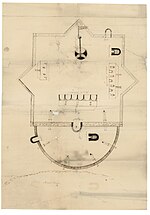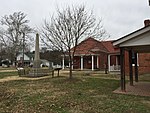Kittiewan

Kittiewan, originally known as Millford, is a historic plantation house near New Hope, Charles City County, Virginia, US, built in the 18th century. it is a typical Colonial-period medium-size wood-frame Virginia Tidewater plantation house, comprising a 1+1⁄2-story, main section with a gable roof, with an original gable-roofed ell and later lean-to addition. Its first known owner was Dr. William Rickman, the first Director of Hospitals of the Continental Army in Virginia during the American Revolution. Stewardship of the house and surrounding 720 acres (2.9 km2) is administered by the Archeological Society of Virginia. The house and grounds are open to the public by appointment. It was added to the National Register of Historic Places in 1978.
Excerpt from the Wikipedia article Kittiewan (License: CC BY-SA 3.0, Authors, Images).Kittiewan
Weyanoke Road,
Geographical coordinates (GPS) Address Website External links Nearby Places Show on map
Geographical coordinates (GPS)
| Latitude | Longitude |
|---|---|
| N 37.301388888889 ° | E -77.0475 ° |
Address
Historic Kittiewan Manor House & Museum (Kittiewan)
Weyanoke Road 12106
23030
Virginia, United States
Open on Google Maps








